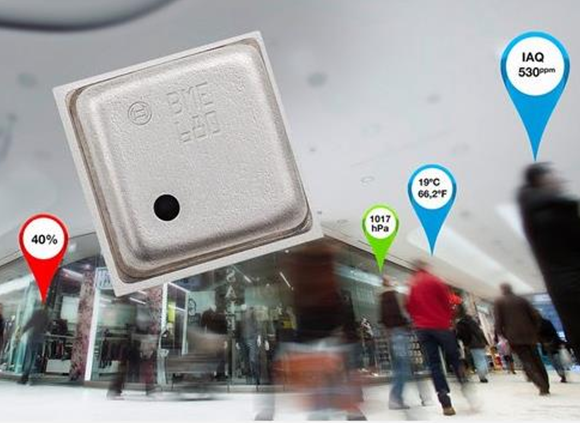Companies like Sensirion, Bosch and STMicro take the lead in the development of ultra-mini, low-power and high-performance sensors with semiconductor and MEMS technologies
As IoT proliferates, demand for environmental sensors is also rapidly escalating. With environmental sensors mainly using semiconductor and MEMS technologies, current trends in the field include MEMS processing and multi-chip packaging technologies contributing to miniaturization, SoC (system on a chip) technology bringing about high performance and mass production and yield improvement aiming at low price.
 ▲Ultra-min composite sensors from Sensirion integrate gas and pressure sensors.
Demand for composite sensors on the rise
▲Ultra-min composite sensors from Sensirion integrate gas and pressure sensors.
Demand for composite sensors on the rise
Including temperature/humidity sensors, gas/pressure sensors, ultraviolet sensors, water quality sensors, dust sensors, etc., environmental sensors provide real-time monitoring of such environmental factors as water quality, atmosphere, environmental pollution materials in eco systems, etc. which influence human lives.
Temperature sensors can be classified into contact type and non-contact type depending on their method of use. Contact type temperature sensors include RTD, thermistor (NTC and PTC), IC temperature sensor, etc. Non-contact type temperature sensors include thermopile, pyroelectric sensors, etc.
IC temperature sensors enable even developers with almost no knowledge of thermal design to use them, with flexibility to add more functionality in the final applications. They are relatively inexpensive, have very small footprint and low power consumption and are provided in a variety of output format. Representative companies include Sensirion, Texas Instruments (TMP112-Q1), STMicro (STTS751), Silicon Labs (Si7053), etc.

▲
Digital temperature sensors from STMicroelectronic (STTS751)
Humidity sensors can be classified into impedance type and capacitive type. Humidity/temperature sensor modules capable of measuring both humidity and temperature are available in ultra-mini, high-performance and low-power models with digital outputs. They are available from IST AG (P14 2FW Thermo), Samyoung S&C (HumiChip), Sensirion (SHT1x), STMicroelectronics (HTS221), etc.
Pressure sensors are classified into Piezoresistive type and Capacitive type. Most of MEMS pressure sensor technologies are possessed by companies in Europe, USA and Japan, in which R&D of miniaturization, high functionality and new processing technologies are actively in progress. Pressure sensor area is leaded by such companies as Omron, STMicroelectronics (LPS22HB), Bosche Sensortec (BMP280), etc. Bosch, in particular, has integrated temperature, humidity and pressure sensors into advanced composite sensors with tiny footprint, low power consumption and high performance.
Representative gas sensors are semiconductor type, which is capable of sensing most of toxic and combustible gases and is simple to manufacture and made into detection circuits. Companies such as CO2Meter and Bosche Sensortec are leading the market with composite sensors detecting gases as well as temperature, humidity, pressure, etc.
 ▲Combo MEMS solution from Bosch Sensortec integrates pressure, humidity/temperature and gas sensors.
▲Combo MEMS solution from Bosch Sensortec integrates pressure, humidity/temperature and gas sensors.
Ultraviolet sensors are based on either silicon or GaN. Silicon-based ultraviolet sensors are available from STMicroelectronics (UVIS25), Silicon Labs (Si1132), etc. and GaN-based ones are from such local company as GenUV.
Dust sensors measure the dust concentration in gases passing through the sensors with light-scattering detection method.
Young-Min Kim, director of Cubit, said “With the goal of achieving well-being life, environmental sensors and signal processing modules capable of analyzing living environment, as well as service platform technologies interconnected with cloud to provide environmental monitoring and control services, are going to be actively implemented in the future.”